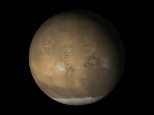MIT and NASA researchers provide first-time measurements of the density and thickness of seasonal snow and frost on Mars in the Dec. 7 issue of Science.
A global view of how Mars changes with the seasons has been provided by extremely precise observations from two investigations by NASA's Mars Global Surveyor spacecraft.
Elevation and gravity measurements of Mars from the Mars Global Surveyor have been used to measure seasonal changes in the thickness of frost deposits and to provide the first direct measurement of their density. The observations were obtained from the Mars Orbiter Laser Altimeter and the spacecraft's radio tracking system.
Over the course of a Martian year, which consists of 687 Earth days, as much as a third of Mars' tenuous carbon dioxide atmosphere "freezes out" during the winter in the northern and southern hemispheres. A team consisting of David E. Smith of NASA's Goddard Space Flight Center and MIT's Maria T. Zuber, professor of earth, atmospheric and planetary sciences (EAPS), and research scientist Gregory A. Neumann of EAPS measured changes in the height of the Martian surface every two weeks. They showed that small changes in surface height correlate with the expected times of deposition and evaporation of CO2 from the surface.
The group also measured miniscule changes in the gravity field of Mars due to the movement of carbon dioxide, which allowed them to make the first measurement of the density of surface frost deposits.
"Snow on Mars is composed of dry ice, and last year it reached a maximum depth of 1.5 to 2 meters near both the north and south poles," said Smith, principal investigator of the laser altimeter investigation and lead author of the study.
"Snow on Mars is denser than it is on Earth, being more ice-like than powdery," said Zuber, the deputy principal investigator of the altimeter investigation.
The group measured changes of 10 centimeters in the height of the surface of Mars, and changes of a couple of parts per billion in the planet's global mass distribution.
The results will allow a better understanding of the Martian atmosphere, which will improve the ability to target future landers. In addition, carbon dioxide is the most abundant gas in the atmosphere of Mars and it is a greenhouse gas. "Characterizing the present-day behavior of CO2 is a necessary first step towards understanding past climates on Mars," Neumann said.
The Mars Global Surveyor is now in its extended mapping mission, which runs until April 2002. Its radio science experiment is implemented from the Center for Radio Astronomy of Stanford University. The Mars Orbiter Laser Altimeter instrument was designed and built by the laser remote sensing branch of the Laboratory for Terrestrial Physics at Goddard. The Mars Global Surveyor mission is managed for NASA's Office of Space Science by the Jet Propulsion Laboratory, a division of Caltech.
A version of this article appeared in MIT Tech Talk on December 12, 2001.






